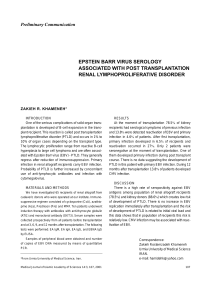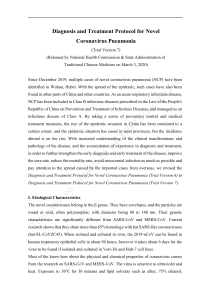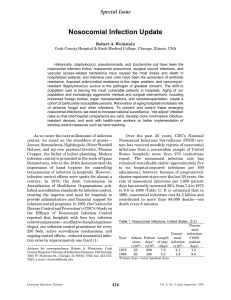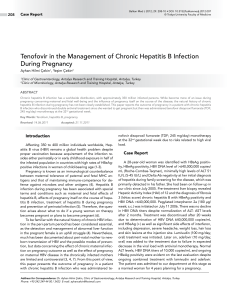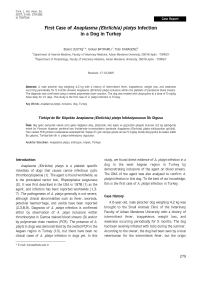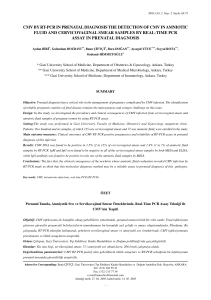Uploaded by
kant.hamza
UpdatedClinicalManagementProtocolforCOVID19dated03072020
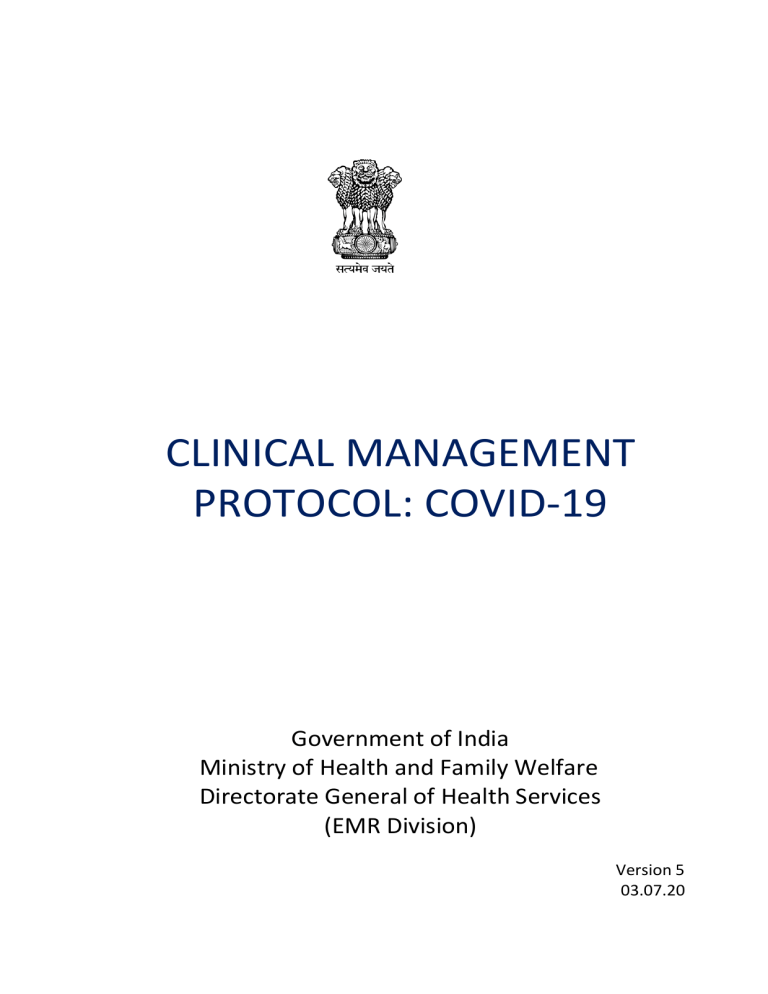
CLINICAL MANAGEMENT PROTOCOL: COVID-19 Government of India Ministry of Health and Family Welfare Directorate General of Health Services (EMR Division) Version 5 03.07.20 Table of Contents 1. Background .............................................................................. 2 2. Disease epidemiology ............................................................... 2 3. Patho-physiology ...................................................................... 2 4. Case definition ......................................................................... 3 5. Clinical features ........................................................................ 3 6. Risk factors ............................................................................... 4 7. Clinical severity ........................................................................ 4 8. Infection prevention and control practices ............................. 8 9. Laboratory diagnosis ..............................................................10 10. Management of COVID-19: symptomatic treatment ..............12 10.1 Management of mild cases .............................................12 10.2 Management of moderate cases.....................................12 10.3 Management of severe cases ..........................................14 11. Investigational therapies: .......................................................18 12. Repurposed or off-label therapies: .........................................19 13. Prevention of complications ...................................................19 Page | 1 1. Background Coronaviruses are large group of viruses that cause illness in humans and animals. Rarely, animal coronaviruses can evolve and infect people and then spread between people such as has been seen with MERS and SARS. The outbreak of Novel coronavirus disease (COVID19) was initially noticed in a seafood market in Wuhan city in Hubei Province of China in mid-December, 2019, has now spread to 214 countries/territories/areas worldwide. WHO (under International Health Regulations) has declared this outbreak as a “Public Health Emergency of International Concern” (PHEIC) on 30thJanuary 2020. WHO subsequently declared COVID-19 a pandemic on 11th March, 2020. 2. Disease Epidemiology Current available evidence for COVID-19 suggests that the causative virus (SARS-CoV-2) has a zoonotic source closely related to bat-origin SARS-like coronavirus. It is an enveloped RNA beta coronavirus related to the Severe Acute Respiratory Syndrome (SARS) virus, and the virus has been shown to use the angiotensin-converting enzyme 2 (ACE2) receptor for cell entry. The persons infected by the novel coronavirus are the main source of infection. Direct person-to-person transmission occurs through close contact, mainly through respiratory droplets that are released when the infected person coughs, sneezes, or talks. These droplets may also land on surfaces, where the virus remains viable. Infection can also occur if a person touches an infected surface and then touches his or her eyes, nose, or mouth. The median incubation period is 5.1 days (range 2–14 days). The precise interval during which an individual with COVID-19 is infectious is uncertain. As per the current evidence, the period of infectivity starts 2 days prior to onset of symptoms and lasts up to 8 days. The extent and role played by pre-clinical/ asymptomatic infections in transmission still remain under investigation. 3. Patho-physiology Most patients with COVID-19 predominantly have a respiratory tract infection associated with SARS-CoV-2 infection. However, in a small proportion of cases, they can progress to a more severe and systemic disease characterized by the Acute Respiratory Distress Syndrome (ARDS), sepsis and septic shock, multiorgan failure, including acute kidney injury and cardiac injury. Autopsy findings in China and European countries showed endothelial damage of pulmonary vasculature, microvascular thrombosis and hemorrhage linked to extensive alveolar and interstitial inflammation that ultimately result in COVID-19 vasculopathy, pulmonary intravascular coagulopathy, hypercoagulability, ventilation perfusion Page | 2 mismatch, and refractory ARDS. Hypoxemia, secondary to ARDS may also activate the coagulation cascade. 4. Case definition1 Suspect case A. A patient with acute respiratory illness (fever and at least one sign/symptom of respiratory disease, e.g., cough, shortness of breath), AND a history of travel to or residence in a location reporting community transmission of COVID-19 disease during the 14 days prior to symptom onset; OR B. A patient with any acute respiratory illness AND having been in contact with a confirmed or probable COVID-19 case in the last 14 days prior to symptom onset; OR C. A patient with severe acute respiratory illness (fever and at least one sign/symptom of respiratory disease, e.g., cough, shortness of breath; AND requiring hospitalization) AND in the absence of an alternative diagnosis that fully explains the clinical presentation. Probable case A. A suspect case for whom testing for the COVID-19 virus is inconclusive. OR B. A suspect case for whom testing could not be performed for any reason. Confirmed case A person with laboratory confirmation of COVID-19 infection, irrespective of clinical signs and symptoms. 5. Clinical Features COVID-19 patients reporting to various Covid treatment facilities have reported the following signs and symptoms: 1 Fever Cough Fatigue Shortness of breath Expectoration Myalgia Rhinorrhea, sore throat, diarrhea As per WHO surveillance guidelines Page | 3 Loss of smell (anosmia) or loss of taste (ageusia) preceding the onset of respiratory symptoms has also been reported Older people and immune-suppressed patients in particular may present with atypical symptoms such as fatigue, reduced alertness, reduced mobility, diarrhoea, loss of appetite, delirium, and absence of fever. Children might not have reported fever or cough as frequently as adults. As per data from Integrated Health Information Platform (IHIP)/ Integrated Disease Surveillance Programme (IDSP) portal case investigation forms for COVID 19 (n=15,366), the details on the signs and symptoms reported are (as on 11.06.2020), fever (27%), cough (21%), sore throat (10%), breathlessness (8%), Weakness (7%), running nose (3%) and others 24%. 6. Risk factors The major risk factors for severe disease are: Age more than 60 years (increasing with age). Underlying non-communicable diseases (NCDs): diabetes, hypertension, cardiac disease, chronic lung disease, cerebro-vascular disease, chronic kidney disease, immune-suppression and cancer 7. Clinical Severity Table 1: Clinical severity and assessment parameters Clinical Severity Mild2 Clinical presentation Patients with uncomplicated upper respiratory tract infection, may have mild symptoms such as fever, cough, sore throat, nasal congestion, malaise, headache Clinical parameters Remarks Without evidence of (i) Managed at breathlessness or Hypoxia (normal Covid Care saturation). Centre 2 Revised guidelines for Home Isolation of very mild/asymptomatic COVID-19 cases (https://www.mohfw.gov.in/pdf/RevisedHomeIsolationGuidelines.pdf) Page | 4 Moderate Pneumonia with no signs of severe disease Adolescent or adult with presence of clinical features of dyspnea and or hypoxia, fever, cough, including SpO2 <94% (range 90-94%) on room air, Respiratory Rate more or equal to 24 per minute. Managed in Dedicated Covid Health Centre (DCHC) Child with presence of clinical features of dyspnea and or hypoxia, fever, cough, including SpO2 <94% (range 90-94%) on room air, Respiratory Rate more or equal to 24 per minute. Fast breathing (in breaths/min): < 2 months: ≥ 60; 2–11 months: ≥ 50; 1–5 years: ≥ 40 Severe Severe Pneumonia Adolescent or adult: with clinical Managed in signs of Pneumonia plus one of the Dedicated Covid following; respiratory rate >30 Hospital breaths/min, severe respiratory distress, SpO2 <90% on room air. Child with cough or difficulty in breathing, plus at least one of the following: central cyanosis or SpO2 <90%; severe respiratory distress (e.g. grunting, chest in- drawing); signs of pneumonia with any of the following danger signs: inability to breastfeed or drink, lethargy or unconsciousness, or convulsions. Other signs of pneumonia may be present: chest in drawing, fast breathing (in breaths/min): <2 months ≥60; 2– 11 months ≥50; 1–5 years ≥40. The diagnosis is clinical; chest imaging can exclude complications. Page | 5 Acute Respiratory Distress Syndrome Onset: new or worsening respiratory symptoms within one week of known clinical insult. Chest imaging (Chest X ray and portable bed side lung ultrasound): bilateral opacities, not fully explained by effusions, lobar or lung collapse, or nodules. Origin of Pulmonary infiltrates: respiratory failure not fully explained by cardiac failure or fluid overload. Need objective assessment (e.g. echocardiography) to exclude hydrostatic cause of infiltrates/ oedema if no risk factor present. Oxygenation adults: impairment in Mild ARDS: 200 mmHg < PaO2/FiO2 ≤ 300 mmHg (with PEEP or CPAP ≥5 cm H2O) Moderate ARDS: 100 mmHg < PaO2/FiO2 ≤200 mmHg with PEEP ≥5 cm H2O) Severe ARDS: PaO2/FiO2 ≤ 100 mmHg with PEEP ≥5 cm H2O) When PaO2 is not available, SpO2/FiO2 ≤315 suggests ARDS (including in non- ventilated patients) Oxygenation Children impairment in Note Oxygenation Index (OI) and OSI (Oxygen Saturation Index) Use OI when available. If PaO2 not available, wean FiO2 to maintain SpO2 <_97% to calculate OSI or SpO2/FiO2 ratio: Page | 6 using SpO2) Bi-level (NIV or CPAP) ≥5 cm H2O via full face mask: PaO2/FiO2 ≤ 300 mmHg or SpO2/FiO2 ≤264 Mild ARDS (invasively ventilated): 4 ≤ OI < 8 or 5 ≤ OSI < 7.5 Moderate ARDS (invasively ventilated): 8 ≤ OI < 16 or 7.5 ≤ OSI < 12.3 Severe ARDS ventilated): (invasively OI ≥ 16 or OSI ≥ 12.3 Severe (Continued) Sepsis Adults: Acute life-threatening organ dysfunction caused by a dysregulated host response to suspected or proven infection. Signs of organ dysfunction include: altered mental status, difficult or fast breathing, low oxygen saturation, reduced urine output, fast heart rate, weak pulse, cold extremities or low blood pressure, skin mottling, or laboratory evidence of coagulopathy, thrombocytopenia, acidosis, high lactate or hyperbilirubinemia. Children: suspected or proven infection and ≥2 age based Systemic Inflammatory Response Syndrome (SIRS) criteria, of which one must be abnormal temperature or white blood cell count Septic Shock Adults: persisting hypotension despite volume resuscitation, requiring vasopressors to maintain MAP ≥65 mmHg and serum lactate level > 2 mmol/L Children: any hypotension (SBP <5th centile or >2 SD below Page | 7 normal for age) or 2- 3 of the following: altered mental state; bradycardia or tachycardia (HR <90 bpm or >160 bpm in infants and HR <70 bpm or >150 bpm in children); prolonged capillary refill (>2 sec) or weak pulse; tachypnea; mottled or cool skin or petechial or purpuric rash; high lactate; reduced urine output ; hyperthermia or hypothermia 8. Infection Prevention and Control Practices3 Infection prevention control (IPC) is a critical and integral part of clinical management of patients and should be initiated at the point of entry of the patient to hospital (typically the Emergency Department). Standard precautions should always be routinely applied in all areas of health care facilities. Standard precautions include hand hygiene; use of PPE to avoid direct contact with patients’ blood, body fluids, secretions (including respiratory secretions) and non-intact skin. Standard precautions also include prevention of needlestick or sharps injury; safe waste management; cleaning and disinfection of equipment; and cleaning of the environment. Table 2: Infection prevention control practices At triage 3 Give suspect patient a triple layer surgical mask and direct patient to separate area, an isolation room if available. Keep at least 1meter distance between suspected patients and other patients. Instruct all patients to cover nose and mouth during coughing or sneezing with tissue or flexed elbow for others. Perform hand hygiene after contact with respiratory secretions National guidelines for infection prevention and control in healthcare https://www.mohfw.gov.in/pdf//National%20Guidelines%20for%20IPC%20in%20HCF%20%20final%281%29.pdf facilities Page | 8 Apply standard precautions Apply standard precautions according to risk assessment for all patients, at all times, when providing any diagnostic and care services. Standard precautions include hand hygiene and the use of personal protective equipment (PPE) when risk of splashes or in contact with patients’ blood, body fluids, secretions (including respiratory secretions) and non-intact skin. Standard precautions also include appropriate patient placement; prevention of needle- stick or sharps injury; safe waste management; cleaning and disinfection of equipment; and cleaning of the environment. Best practices for safely managing health care waste should be followed. Apply droplet precautions Droplet precautions prevent large droplet transmission of respiratory viruses. Use a triple layer surgical mask if working within 1-2 meters of the patient. Place patients in single rooms, or group together those with the same etiological diagnosis. If an etiological diagnosis is not possible, group patients with similar clinical diagnosis and based on epidemiological risk factors, with a spatial separation. When providing care in close contact with a patient with respiratory symptoms (e.g. coughing or sneezing), use eye protection (face-mask or goggles), because sprays of secretions may occur. Limit patient movement within the institution and ensure that patients wear triple layer surgical masks when outside their rooms Apply contact precautions Droplet and contact precautions prevent direct or indirect transmission from contact with contaminated surfaces or equipment (i.e. contact with contaminated oxygen tubing/interfaces). Use PPE (triple layer surgical mask, eye protection, gloves and gown) when entering room and remove PPE when leaving. If possible, use either disposable or dedicated equipment (e.g. stethoscopes, blood pressure cuffs and thermometers). If equipment needs to be shared among patients, clean and disinfect between each patient use. Ensure that health care workers refrain from touching their eyes, nose, and mouth with potentially contaminated gloved or ungloved hands. Avoid contaminating environmental surfaces that are not directly related to patient care (e.g. door handles and light switches). Ensure adequate room ventilation. Avoid movement of patients or transport. Perform hand hygiene. Page | 9 Apply airborne precautions when performing an aerosol generating procedure Ensure that healthcare workers performing aerosol-generating procedures (i.e. open suctioning of respiratory tract, intubation, bronchoscopy, cardiopulmonary resuscitation) use PPE, including gloves, long-sleeved gowns, eye protection, and fit-tested particulate respirators (N95). (The scheduled fit test should not be confused with user seal check before each use.) Whenever possible, use adequately ventilated single rooms when performing aerosol-generating procedures, meaning negative pressure rooms with minimum of 12 air changes per hour or at least 160 liters/second/patient in facilities with natural ventilation. Avoid the presence of unnecessary individuals in the room. Care for the patient in the same type of room after mechanical ventilation commences. Because of uncertainty around the potential for aerosolization, highflow nasal oxygen (HFNO), NIV, including bubble CPAP, should be used with airborne precautions until further evaluation of safety can be completed. There is insufficient evidence to classify nebulizer therapy as an aerosol-generating procedure that is associated with transmission of COVID-19. More research is needed. 9. Laboratory Diagnosis Guidance on specimen collection, processing, transportation, including related biosafety procedures, is available at: https://www.mohfw.gov.in/pdf/5Sample%20collection_packaging%20%202019-nCoV.pdf Sample collection Preferred sample Throat and nasal swab in viral transport media (VTM) and transported in cold chain. Alternate Nasopharyngeal swab, BAL or endotracheal aspirate which has to be mixed with the viral transport medium and transported in cold chain. General guidelines Use appropriate PPE for specimen collection (droplet and contact precautions for URT specimens; airborne precautions for LRT specimens). Maintain proper infection control when collecting specimens Restricted entry to visitors or attendants during sample collection Complete the requisition form for each specimen submitted Proper disposal of all waste generated Page | 10 Respiratory specimen collection methods: A. Lower respiratory tract Bronchoalveolar lavage, tracheal aspirate, sputum Collect 2-3 mL into a sterile, leak-proof, screw-cap sputum collection cup or sterile dry container. B. Upper respiratory tract Nasopharyngeal swab AND oropharyngeal swab Oropharyngeal swab (e.g. throat swab): Tilt patient’s head back 70 degrees. Rub swab over both tonsillar pillars and posterior oropharynx and avoid touching the tongue, teeth, and gums. Use only synthetic fiber swabs with plastic shafts. Do not use calcium alginate swabs or swabs with wooden shafts. Place swabs immediately into sterile tubes containing 2-3 ml of viral transport media. Combined nasal & throat swab: Tilt patient’s head back 70 degrees. While gently rotating the swab, insert swab less than one inch into nostril (until resistance is met at turbinates). Rotate the swab several times against nasal wall and repeat in other nostril using the same swab. Place tip of the swab into sterile viral transport media tube and cut off the applicator stick. For throat swab, take a second dry polyester swab, insert into mouth, and swab the posterior pharynx and tonsillar areas (avoid the tongue). Place tip of swab into the same tube and cut off the applicator tip. Nasopharyngeal swab: Tilt patient’s head back 70 degrees. Insert flexible swab through the nares parallel to the palate (not upwards) until resistance is encountered or the distance is equivalent to that from the ear to the nostril of the patient. Gently, rub and roll the swab. Leave the swab in place for several seconds to absorb secretions before removing. Clinicians may also collect lower respiratory tract samples when these are readily available (for example, in mechanically ventilated patients). In hospitalized patients in Dedicated Covid Hospitals (severe cases with confirmed COVID - 19 infection, repeat upper respiratory tract samples should be collected to demonstrate viral clearance. Recommended Test Real time or Conventional RT-PCR test is recommended for diagnosis. SARS-CoV-2 antibody tests are not recommended for diagnosis of current infection with COVID-19. Dual infections with other respiratory infections (viral, bacterial and fungal) have been found in COVID-19 patients. Depending on local epidemiology and clinical symptoms, test for other potential etiologies (e.g. Influenza, other respiratory viruses, malaria, dengue fever, typhoid fever) as appropriate. For COVID-19 patients with severe disease, also collect blood cultures, ideally prior to initiation of antimicrobial therapy Page | 11 10. Management of COVID-19: symptomatic treatment 10.1. Management of Mild Cases In the containment phase, patients with suspected or confirmed mild COVID-19 are being isolated to break the chain of transmission. Patients with mild disease may present to primary care/outpatient department, or detected during community outreach activities, such as home visits or by telemedicine. Mild cases can be managed at Covid Care Centre, First Referral Units (FRUs), Community Health Centre (CHC), sub-district and district hospitals. Detailed clinical history is taken including that of co-morbidities. Patient is followed up daily for temperature, vitals and Oxygen saturation (SpO2). Patients should be monitored for signs and symptoms of complications that should prompt urgent referral. Patients with risk factors for severe illness should be monitored closely, given the possible risk of deterioration. If they develop any worsening symptoms (such as mental confusion, difficulty breathing, persistent pain or pressure in the chest, bluish coloration of face/lips, dehydration, decreased urine output, etc.), they should be immediately admitted to a Dedicated Covid Health Centre or Dedicated Covid Hospital. Children with mild COVID-19 should be monitored for signs and symptoms of clinical deterioration requiring urgent re-evaluation. These include difficulty in breathing/fast or shallow breathing (for infants: grunting, inability to breastfeed), blue lips or face, chest pain or pressure, new confusion, inability to awaken/not interacting when awake, inability to drink or keep down any liquids. Mild COVID-19 cases may be given: 1. Symptomatic treatment such as antipyretic (Paracetamol) for fever and pain, antitussives for cough 2. Adequate nutrition and appropriate hydration to ensured. 3. Tab Hydroxychloroquine (HCQ) may be considered for any of those having high risk features for severe disease (such as age> 60 years; Hypertension, diabetes, chronic lung/kidney/ liver disease, Cerebrovascular disease and obesity) under strict medical supervision, preferably after shifting to DCHC/DCH. 4. Avoid HCQ in patients with underlying cardiac disease, history of unexplained syncope or QT prolongation (> 480 ms). 10.2. Management of Moderate Cases Patients with suspected or confirmed moderate COVID-19 (pneumonia) is to be isolated to contain virus transmission. Patients with moderate disease may present to an emergency unit or primary care/outpatient department, or be encountered during community surveillance activities, such as active house to house search or by telemedicine. The defining clinical assessment parameters are Respiratory Rate of more than or equal to 24 per minute and oxygen saturation (SpO2) of less than 94% on room air (range 90-94%). Page | 12 Such patients will be isolated in Dedicated Covid Health Centre (DCHC) or District hospital or Medical College hospitals. The patient will undergo detailed clinical history including co-morbid conditions, measurement of vital signs, Oxygen saturation (SpO2) and radiological examination of Chest X-ray, Complete Blood Count and other investigations as indicated. Antibiotics should not be prescribed routinely unless there is clinical suspicion of a bacterial infection. Clinical Management of Moderate cases 1. Symptomatic treatment such as antipyretic (Paracetamol) for fever and pain, antitussives for cough 2. Adequate hydration to be ensured 3. Oxygen Support: Target SpO2: 92-96% (88-92% in patients with COPD) The device for administering oxygen (nasal prongs, mask, or masks with breathing / non-rebreathing reservoir bag) depends upon the increasing requirement of oxygen therapy. If HFNC or simple nasal cannula is used, N95 mask should be applied over it. Awake proning may be used as a rescue therapy. (Protocol at Annexure-I) Criteria to be fulfilled Patients with oxygen requirement of >4L Normal mental status Able to self-prone or change position with minimal assistance Avoid proning Hemodynamic instability Close monitoring not possible Patients will undergo a rotational change in position from prone to lying on each side to sitting up. Typical protocols include 30–120 minutes in prone position, followed by 30– 120 minutes in left lateral decubitus, right lateral decubitus, and upright sitting position. All patients should have daily 12-lead ECG 4. Anticoagulation Prophylactic dose of UFH or LMWH (e.g., enoxaparin 40 mg per day SC) *Contraindications: End stage renal disease, active bleeding, emergency surgery **Consider unfractionated heparin in ESRD 5. Corticosteroids Consider IV methylprednisolone 0.5 to 1 mg/kg OR Dexamethasone 0.1 to 0.2 mg/kg for 3 days (preferably within 48 hours of admission or if oxygen requirement is increasing and if inflammatory markers are increased). Review the duration of administration as per clinical response. Page | 13 6. Anti-virals Tab. Hydroxychloroquine (400mg) BD on 1st day followed by 200mg 1 BD for 4 days. (after ECG Assessment) May consider investigational therapies such as Remdesivir (under EUA); Convalescent Plasma (Off label use) as detailed under Section 11. 7. Control of co-morbid condition 8. Follow up CRP, D-dimer & Ferritin every 48-72 hourly (if available); CBC with differential count, Absolute Lymphocyte count, KFT/LFT daily 9. Monitor for: • Increased work of breathing (use of accessary muscles) • Hemodynamic instability • Increase in oxygen requirement If any of the above occurs, shift to Dedicated Covid Hospital Few patients with COVID-19 experience a secondary bacterial infection. Consider empiric antibiotic therapy as per local antibiogram and guidelines in older people, immunecompromised patients, and children < 5 years of age. Close monitoring of patients with moderate COVID-19 is required for signs or symptoms of disease progression. Provision of mechanisms for follow up and transportation to Dedicated Covid Hospital should be available. 10.3. Management of Severe Cases 10.3.1 Early supportive therapy and monitoring 1. Symptomatic treatment with paracetamol and antitussives to continue 2. Oxygenation: Give supplemental oxygen therapy immediately to patients with Severe Covid and respiratory distress, hypoxaemia, or shock: Initiate oxygen therapy at 5 L/min and titrate flow rates to reach target SpO2 ≥ 90% in non-pregnant adults and SpO2 ≥ 92- 96% in pregnant patients. Children with emergency signs (obstructed or absent breathing, severe respiratory distress, central cyanosis, shock, coma or convulsions) should receive oxygen therapy during resuscitation to target SpO2≥94%. All areas where patients with Severe Covid are cared for should be equipped with pulse oximeters, functioning oxygen systems and disposable, singleuse, oxygen-delivering interfaces (nasal cannula, simple face mask, and mask with reservoir bag). Use contact precautions when handling contaminated oxygen interfaces of patients with COVID – 19. 3. Use conservative fluid management in patients with Severe Covid when there is no evidence of shock. 4. Anticoagulation: High prophylactic dose of UFH/ LMWH (e.g. enoxaparin 40 mg BD SC) if not at high risk of bleeding. *Contraindications: End stage renal disease, active bleeding, emergency surgery Page | 14 ** Consider unfractionated heparin in ESRD 5. Corticosteroids: IV Methylprednisolone 1-2 mg/kg or Dexamethasone 0.2-0.4 mg/kg for 5-7 days 6. Investigational therapy: Tocilizumab (Off Label) Anti IL-6 therapy may be considered as detailed under Section 11. 10.3.2 Management of hypoxemic respiratory failure and ARDS Recognize severe hypoxemic respiratory failure when a patient with respiratory distress is failing standard oxygen therapy. Patients may continue to have increased work of breathing or hypoxemia even when oxygen is delivered via a face mask with reservoir bag (flow rates of 10-15 L/min, which is typically the minimum flow required to maintain bag inflation; FiO2 0.60-0.95). Hypoxemic respiratory failure in ARDS commonly results from intrapulmonary ventilation- perfusion mismatch or shunt and usually requires mechanical ventilation. Lung protective ventilation strategy by ARDS net protocol: Tidal volume 6ml/kg, RR 15-35/min, PEEP 5-15cm H2O; target plateau pressure < 30cm H2O, target SpO2 88-95% and/or PaO2 55-80mmHg Prone ventilation to be considered when there is refractory hypoxemia; PaO2/FiO2 ratio <150 with FiO2> 0.6 with PEEP > 5cm H2O. High – Flow Nasal Cannula oxygenation (HFNO) or non – invasive mechanical ventilation: When respiratory distress and/or hypoxemia of the patient cannot be alleviated after receiving standard oxygen therapy, high – flow nasal cannula oxygen therapy or non – invasive ventilation can be considered. Compared to standard oxygen therapy, HFNO reduces the need for intubation. Patients with hypercapnia (exacerbation of obstructive lung disease, cardiogenic pulmonary oedema), hemodynamic instability, multi-organ failure, or abnormal mental status should generally not receive HFNO, although emerging data suggest that HFNO may be safe in patients with mild- moderate and nonworsening hypercapnia. Patients receiving HFNO should be in a monitored setting and cared for by experienced personnel capable of endotracheal intubation in case the patient acutely deteriorates or does not improve after a short trial (about 1 hr). NIV: setting - PS 5-15 cmH2O adjusted to tidal volume of 5-7 ml/kg and PEEP 5-10 cm H2O and FiO2 @ 0.5 -1.0 titrated to target SpO2> 94%. There have been concerns raised about generation of aerosols while using HFNO and NIV. However, recent publications suggest that newer HFNO and NIV systems with good interface fitting do not create widespread dispersion of exhaled air and therefore should be associated with low risk of airborne transmission. If conditions do not improve or even get worse within a short time (1 – 2 hours), tracheal intubation and invasive mechanical ventilation should be used in a timely manner. Endotracheal intubation should be performed by a trained and experienced provider using airborne precautions. Patients with ARDS, especially young children Page | 15 or those who are obese or pregnant, may de-saturate quickly during intubation. Preoxygenate with 100% FiO2 for 5 minutes, via a face mask with reservoir bag, bagvalve mask, HFNO, or NIV. Rapid sequence intubation is appropriate after an airway assessment that identifies no signs of difficult intubation. Implement mechanical ventilation using lower tidal volumes (4–8 ml/kg predicted body weight, PBW) and lower inspiratory pressures (plateau pressure <30 cmH 2O). This is a strong recommendation from a clinical guideline for patients with ARDS, and is suggested for patients with sepsis-induced respiratory failure. The initial tidal volume is 6 ml/kg PBW; tidal volume up to 8 ml/kg PBW is allowed if undesirable side effects occur (e.g. dys-synchrony, pH <7.15). Hypercapnia is permitted if meeting the pH goal of 7.307.45. Ventilator protocols are available. The use of deep sedation may be required to control respiratory drive and achieve tidal volume targets. In patients with severe ARDS, prone ventilation for 16-18 hours per day is recommended but requires sufficient human resources and expertise to be performed safely. (Refer to Annexure-I) In patients with moderate or severe ARDS, higher PEEP instead of lower PEEP is suggested. PEEP titration requires consideration of benefits (reducing atelect trauma and improving alveolar recruitment) vs. risks (end-inspiratory over distension leading to lung injury and higher pulmonary vascular resistance). Tables are available to guide PEEP titration based on the FiO2 required to maintain SpO2. In patients with moderatesevere ARDS (PaO2/FiO2<150), neuromuscular blockade by continuous infusion should not be routinely used. In settings with access to expertise in extracorporeal life support (ECLS), consider referral of patients with refractory hypoxemia despite lung protective ventilation. ECLS should only be offered in expert centres with a sufficient case volume to maintain expertise and that can apply the IPC measures required for COVID – 19 patients. Avoid disconnecting the patient from the ventilator, which results in loss of PEEP and atelectasis. Use in-line catheters for airway suctioning and clamp endotracheal tube when disconnection is required (for example, transfer to a transport ventilator). 10.3.3 Management of septic shock Recognize septic shock in adults when infection is suspected or confirmed AND vasopressors are needed to maintain mean arterial pressure (MAP) ≥65 mmHg AND lactate is >2 mmol/L, in absence of hypovolemia. Recognize septic shock in children with any hypotension (systolic blood pressure [SBP] <5th centile or >2 SD below normal for age) or two of the three of the following: altered mental state; tachycardia or bradycardia (HR <90 bpm or >160 bpm in infants and HR<70 bpm or >150 bpm in children); prolonged capillary refill (>2 sec) or warm vasodilation with bounding pulses; tachypnea; mottled skin or petechial or purpuric rash; increased lactate; oliguria; hyperthermia or hypothermia. In the absence of a lactate measurement, use MAP and clinical signs of perfusion to define shock. Standard care includes early recognition and the following treatments within 1 hour of recognition: antimicrobial therapy and fluid loading and vasopressors for hypotension. The use of central venous and arterial catheters should be based on Page | 16 resource availability and individual patient needs. In resuscitation from septic shock in adults, give at least 30 ml/kg of isotonic crystalloid in adults in the first 3 hours. In resuscitation from septic shock in children in wellresourced settings, give 20 ml/kg as a rapid bolus and up to 40-60 ml/kg in the first 1 hr. Do not use hypotonic crystalloids, starches, or gelatins for resuscitation. Fluid resuscitation may lead to volume overload, including respiratory failure. If there is no response to fluid loading and signs of volume overload appear (for example, jugular venous distension, crackles on lung auscultation, pulmonary oedema on imaging, or hepatomegaly in children), then reduce or discontinue fluid administration. This step is particularly important where mechanical ventilation is not available. Alternate fluid regimens are suggested when caring for children in resource- limited settings. Crystalloids include normal saline and Ringer’s lactate. Determine need for additional fluid boluses (250-1000 ml in adults or 10-20 ml/kg in children) based on clinical response and improvement of perfusion targets. Perfusion targets include MAP (>65 mmHg or age- appropriate targets in children), urine output (>0.5 ml/kg/hr in adults, 1 ml/kg/hr. in children), and improvement of skin mottling, capillary refill, level of consciousness, and lactate. Consider dynamic indices of volume responsiveness to guide volume administration beyond initial resuscitation based on local resources and experience. These indices include passive leg raising test, fluid challenges with serial stroke volume measurements, or variations in systolic pressure, pulse pressure, inferior vena cava size, or stroke volume in response to changes in intrathoracic pressure during mechanical ventilation. Administer vasopressors when shock persists during or after fluid resuscitation. The initial blood pressure target is MAP ≥ 65 mmHg in adults and age-appropriate targets in children. If central venous catheters are not available, vasopressors can be given through a peripheral IV, but use a large vein and closely monitor for signs of extravasation and local tissue necrosis. If extravasation occurs, stop infusion. Vasopressors can also be administered through intraosseous needles. If signs of poor perfusion and cardiac dysfunction persist despite achieving MAP target with fluids and vasopressors, consider an inotrope such as dobutamine. 10.3.4. Other therapeutic measures For patients with progressive deterioration of oxygenation indicators, rapid worsening on imaging and excessive activation of the body’s inflammatory response, glucocorticoids can be used for a short period of time (3 to 5 days). It is recommended that dose should not exceed the equivalent of Methylprednisolone 1 – 2mg/kg/day OR Dexamethasone 0.2-0.4 mg/kg/day. Note that a larger dose of glucocorticoid will delay the removal of coronavirus due to immunosuppressive effects. Prophylactic dose of UFH or LMWH (e.g., enoxaparin 40 mg per day SC) should be given for anti-coagulation. Control of co-morbid conditions should be ensured. For pregnant severe cases, consultations with obstetric, neonatal, and intensive care specialists (depending on the condition of the mother) are essential. Patients often suffer Page | 17 from anxiety and fear and they should be supported by psychological counseling. Note – An algorithm for clinical guidance for management of COVID-19 suspect/confirmed case is placed at Annexure-II. 11. Investigational Therapies4 At present, use of these therapies is based on a limited available evidence. As the situation evolves, and when more data become available, the evidence will be accordingly incorporated, and recommendation upgraded. Further, use of these drugs is subjected to limited availability in the country as of now. Currently, these drugs should only be used in a defined subgroup of patients: i. Remdesivir (under Emergency Use Authorization) may be considered in patients with moderate disease (those on oxygen) with none of the following contraindications: AST/ALT > 5 times Upper limit of normal (ULN) Severe renal impairment (i.e., eGFR < 30ml/min/m2 or need for hemodialysis) Pregnancy or lactating females Children (< 12 years of age) Dose: 200 mg IV on day 1 followed by 100 mg IV daily for 4 days (total 5 days) ii. Convalescent plasma (Off Label) may be considered in patients with moderate disease who are not improving (oxygen requirement is progressively increasing) despite use of steroids. Special prerequisites while considering convalescent plasma include: ABO compatibility and cross matching of the donor plasma Neutralizing titer of donor plasma should be above the specific threshold (if the latter is not available, plasma IgG titer (against S-protein RBD) above 1:640 should be used) Recipient should be closely monitored for several hours post transfusion for any transfusion related adverse events Use should be avoided in patients with IgA deficiency or immunoglobulin allergy Dose: Dose is variable ranging from 4 to 13 ml/kg (usually 200 ml single dose given slowly over not less than 2 hours 4This document will be updated as more data emerge. The document contains some potential off label/investigational use of medications and is based on a consensus of experts along with the available evidence. An informed and shared decision making is essential before prescribing any of these therapies. Page | 18 iii. Tocilizumab (Off Label) may be considered in patients with moderate disease with progressively increasing oxygen requirements and in mechanically ventilated patients not improving despite use of steroids. Long term safety data in COVID 19 remains largely unknown. Special considerations before its use include: Presence of raised inflammatory markers (e.g., CRP, Ferritin, IL-6) Patients should be carefully monitored post Tocilizumab for secondary infections and neutropenia The drug is contraindicated in PLHIV, those with active infections (systemic bacterial/fungal), Tuberculosis, active hepatitis, ANC < 2000/mm3 and Platelet count < 1,00,000/mm3 Dose: 8mg/kg (maximum 800 mg at one time) given slowly in 100 ml NS over 1 hour; dose can be repeated once after 12 to 24 hours if needed 12. Repurposed or off-label therapies Hydroxychloroquine: This drug has demonstrated in vitro activity against SARS-CoV2 and was shown to be clinically beneficial in several small single center studies though with significant limitations. Nonetheless, several large observational studies with severe methodologic limitations have shown no effect on mortality or other clinically meaningful outcomes. As such, the evidence base behind its use remains limited as with other drugs and should only be used after shared decision making with the patients while awaiting the results of ongoing studies. As is the case with other antivirals, this drug should be used as early in the disease course as possible to achieve any meaningful effects and should be avoided in patients with severe disease. An ECG should ideally be done before prescribing the drug to measure QTc interval (and HCQ avoided if QTc is >500 ms) Dose: 400 mg BD on day 1 followed by 400mg daily for next 4 days. 13. Prevention of complications Implement the following interventions (Table 3) to prevent complications associated with critical illness. These interventions are based on Surviving Sepsis or other guidelines, and are generally limited to feasible recommendations based on high quality evidence. Table 3: Prevention of complications Anticipated Outcome Interventions Reduce days of invasive mechanical ventilation Use weaning protocols that include daily assessment for readiness to breathe spontaneously Minimize continuous or intermittent sedation, targeting specific titration endpoints (light sedation unless contraindicated) or with daily interruption of continuous sedative infusions Page | 19 Reduce incidence of ventilator associated pneumonia Oral intubation is preferable to nasal intubation in adolescents and adults Keep patient in semi-recumbent position (head of bed elevation 3045º) Use a closed suctioning system; periodically drain and discard condensate in tubing Use a new ventilator circuit for each patient; once patient is ventilated, change circuit if it is soiled or damaged but not routinely Change heat moisture exchanger when it malfunctions, when soiled, or every 5–7 days Reduce incidence of venous thromboembolism Use pharmacological prophylaxis (low molecular-weight heparin [preferred if available] or heparin 5000 units subcutaneously twice daily) in adolescents and adults without contraindications. For those with contraindications, use mechanical prophylaxis (intermittent pneumatic compression devices). Reduce incidence of catheter related bloodstream infection Use a checklist with completion verified by a real-time observer as reminder of each step needed for sterile insertion and as a daily reminder to remove catheter if no longer needed Reduce incidence of pressure Ulcers Turn patient every two hours Reduce Incidence of stress ulcers and gastrointestinal bleeding Give early enteral nutrition (within24-48 hours of admission) Reduce incidence of ICU-related weakness Actively mobilize the patient early in the course of illness when safe to do so Administer histamine-2 receptor blockers or proton-pump inhibitors in patients with risk factors for GI bleeding. Risk factors for gastrointestinal bleeding include mechanical ventilation ≥ 48 hours, coagulopathy, renal replacement therapy, liver disease, multiple comorbidities, and higher organ failure score Page | 20 Annexure- I Early self-proning in awake, non-intubated patients Any COVID-19 patient with respiratory embarrassment severe enough to be admitted to the hospital may be considered for rotation and early self-proning. Care must be taken to not disrupt the flow of oxygen during patient rotation Typical protocols include 30–120 minutes in prone position, followed by 30–120 minutes in left lateral decubitus, right lateral decubitus, and upright sitting position (Caputo ND, Strayer RJ, Levitan R. Academic Emergency Medicine 2020;27:375–378) Requirements for safe prone positioning in ARDS Pre-oxygenate the patient with FiO2 1.0 Secure the endotracheal tube and arterial and central venous catheters Adequate number of staff to assist in the turn and to monitor the turn Supplies to turn (pads for bed, sheet, protection for the patient) Knowledge of how to perform the turn as well as how to supine the patient in case of an emergency Contraindications to prone ventilation Spinal instability requires special care Intra cranial pressure may increase on turning Rapidly return to supine in case of CPR or defibrillation When to start proning? P/F ratio <150 while being ventilated with FiO2 >0.6 and PEEP >5 cm H2O When to stop proning? When P/F exceeds 150 on FiO2 > 0.6 and > 6 PEEP What portion of the day should patients be kept prone? As much as possible (16-18 hours a day) Adult patients with severe ARDS receive prone positioning for more than 12 hours per day (strong recommendation, moderate-high confidence in effect estimates) (ATS-ERS Guideline. Am J RespirCrit Care Med;2017;195(9):1253-1263) Page | 21 ANNEXURE II
